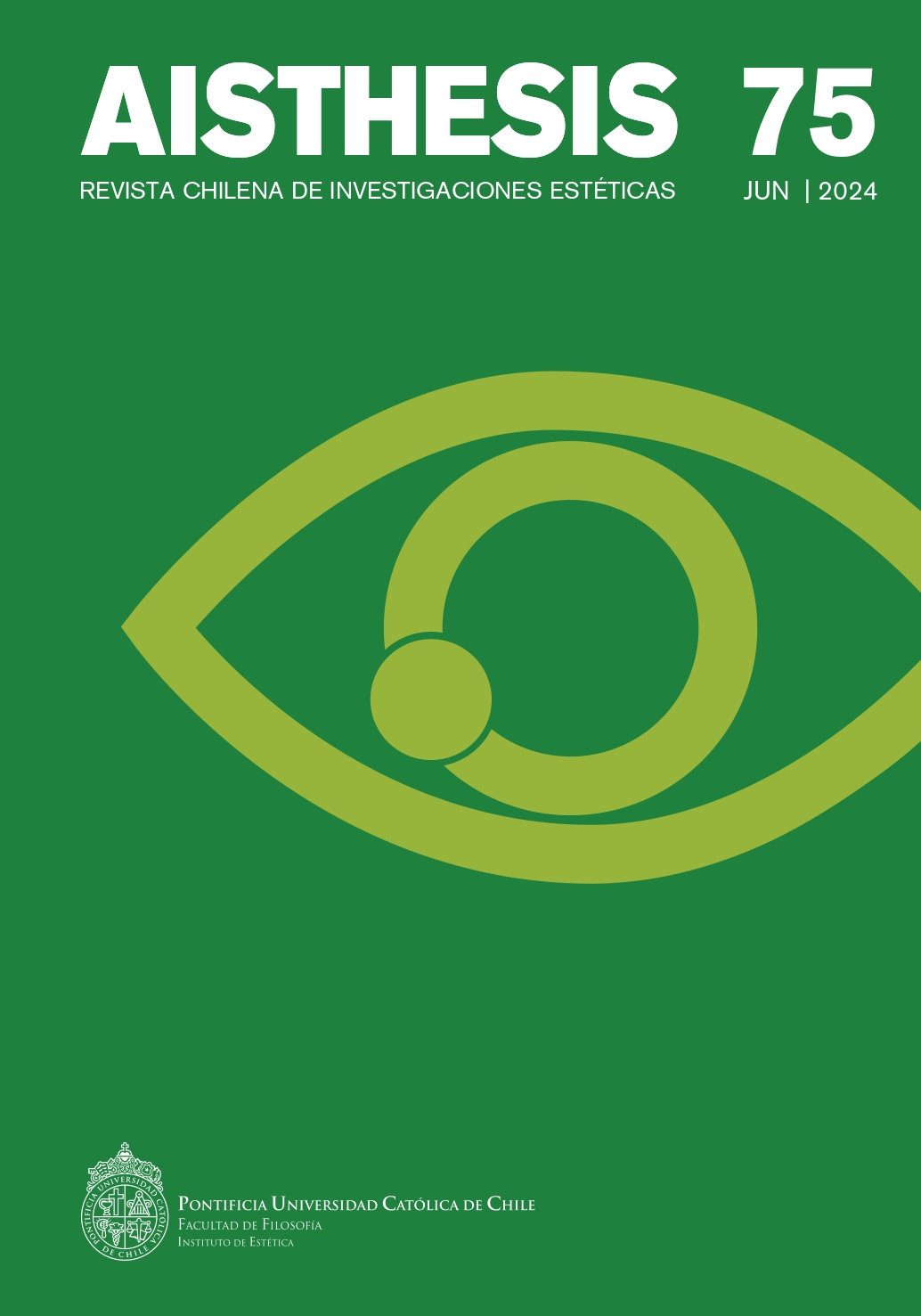The Artwork is a Book, the Wall is a Text Writing and Autobiographical Visuality in Sophie Calle's Work
Main Article Content
Abstract
French artist Sophie Calle (born in Paris in 1953) has been characterized by a hybrid and often unclassifiable body of work. In her pieces, photography, video, and installation converge, alongside autobiographical, logbook, and correspondence writing. Building upon theoretical and conceptual discussions surrounding the textual and visual shifts in thought production, as well as the autobiographical dimension in art, this article aims to explore how Calle integrates and intersects visuality and writing in her work. It delves into how these strategies shape an unprecedented and hybrid—borderline and imperfect—space for autobiographical narrative, impacting the ways in which art addresses one of its central themes: presentation and representation, as well as the notions of truth and fiction inherent within them.
Downloads
Article Details

This work is licensed under a Creative Commons Attribution-NonCommercial-ShareAlike 4.0 International License.
All contents of this electronic edition are distributed under the Creative Commons license of "Attribución-shareAlike 4.0 Internacional" (CC-BY-SA). Any total or partial reproduction of the material must mention its origin.
The rights of academic works published in this publication belong to their authors., who grant to AISTHESIS: Revista Chilena de Investigaciones Estéticas the license for its use. The management of the permits and the authorization of the publication of the images (or of any material) that contains copyright and its consequent rights of reproduction in this publication is the sole responsibility of the authors of the articles
References
Referencias
Álvarez, Ignacio. El curso que hice al revés. Laurel, 2022.
Auster, Paul. Leviatán. Anagrama, 1999.
Barthes, Roland. Diario del duelo. Paidós, 2021.
Calle, Sophie. Douleur exquise. Actes Sud, 2003.
––. Sophie Calle, m'as tu vue. Exhibition catalogue. Centre Pompidou, 2015.
Caminada Rossetti, Lucía. «La mirada entre texto y fotografía: el libro-arte de Sophie Calle.» Revista Laboratorio, nº 25, 2021.
Corradini, Luisa. «Emmanuel Carrère, envuelto en una disputa con su exmujer por la novela Yoga.» La Nación, 3 oct. 2020. https://www.lanacion.com.ar/cultura/emmanuel-carrre-envuelto-disputa-su-exmujer-novela-nid2468791/
Corvalán, Kekena. «Sophie Calle, entre lo público y lo privado.» Cibertronic, nº 7, 2011.
Doubrousky, Serge. Fils. Gallimard, 2001.
Encabo, Jesús Vega. «Los límites de la visibilidad: ciencia e imagen». Coord. Ana García Varas. Filosofía e(n) imággenes: interpretaciones desde el arte y el pensamiento contemporáneos. Institución Fernando el Católico, 2012.
Fontcuberta, Joan. El beso de Judas. Gustavo Gili, 2016.
Foster, Hal. El retorno de lo real. Akal, 2001.
Giovine Yáñez, María Andrea. «Toda obra de artes visuales es iconotextual: una invitación a pensar la historia de las artes visuales desde la relación entre las obras y sus títulos.» Hyperborea, Revista de ensayo y creació, nº 3, 2020.
Guash, Ana María. Autobiografías visuales, del archivo al índice. Siruela, 2009.
Guérin, Michel. «Sophie Calle, entrevistadas por Michel Guérin.» FOAM Magazine, 2012 (primavera).
La Flor, Fernando de. «La cultura de la imagen y el declive de la lecto-escritura.» ARBOR Ciencia, Pensamiento y Cultura, CLXXXVI.743, 2010, pp. 365-375.
Lejeune, Philippe. El pacto autobiográfico y otros estudios. Megazul-Endymion, 1994.
Luis Mora, Vicente. El lectoespectador. Seix Barral, 2012.
Luque, Alejandro. «Annie Ernaux, el arte de escribir a los 80 años sin rehuir ninguna polémica.» elDiario.es, 23 sept. 2019. https://www.eldiario.es/andalucia/annie-ernaux-escribir-rehuir-polemica_1_1349093.html
Luque, Álvaro. «El diario personal en literatura: teoría del diario literario.» Revista Estudios de Literatura, nº 7, 2016, pp. 273-306.
Man, Paul de. «Autobiography As De-Facement.» Paul De Man, The Rhetoric of Romanticism. Columbia University Press, 1984.
Mitchell, W. J. T. Teoría de la imagen. Akal, 2009.
Musitano, Julia. «La autoficción: una aproximación teórica. Entre la retórica de la memoria y la escritura de los recuerdos». Acta literaria, nº 52, 2016, pp. 103-123.
Navarro, Fernando. Medicina en español II: laboratorio del lenguaje. Unión editorial, 2016.
Ortiz Reyes, Isis. La he visto. Estrategias subversivas de representación en la obra de Sophie Calle. Universidad Autónoma Metropolitana, 2010.
Pérez Goiri, Iker. «Lugares demorados: Construcción, orientación y experiencia del espacio poético.» AusArt. Revista para la investigación en Arte, vol. 8, nº 2, 2020, pp. 165-177.
rodríguez freire, raúl. «Presentación. El giro visual en los estudios literarios. Diálogos entre escritura y visualidad.» Revista Chilena de Literatura, nº 107, 2023.
Rojas, Sergio. «Cuerpo y globalización: escalas de percepción». Sergio Rojas, El arte agotado: magnitudes y representaciones de lo contemporáneo. Sangría editora, 2012.
Silva Carreras, Alejandra. «Literatura del yo: reflexiones teóricas perspectivas de autor en el género autobiográfico». Kañiña, vol. 40, nº 2, 2016, pp. 149-158.
Sontag, Susan. Sobre la fotografía. Debolsillo, 2008.
Sophie Calle habla de su obra. Conferencia en la Biblioteca Luis Ángel Arango de Bogotá. Int. Sophie Calle, 2013, Esfera Pública. https://www.youtube.com/watch?v=NYBqfvj4yWE&ab_channel=esferapublica
Vicente, Álex. «Sophie Calle, el voyeurismo hecho arte.» El País, 13 may. 2015. https://elpais.com/elpais/2015/05/13/eps/1431537670_976688.html
Wagner, Peter. Icons, Texts, Iconotexts. Essays on Ekphrasis and Intermediality. Walter de Gruyter, 1996.
